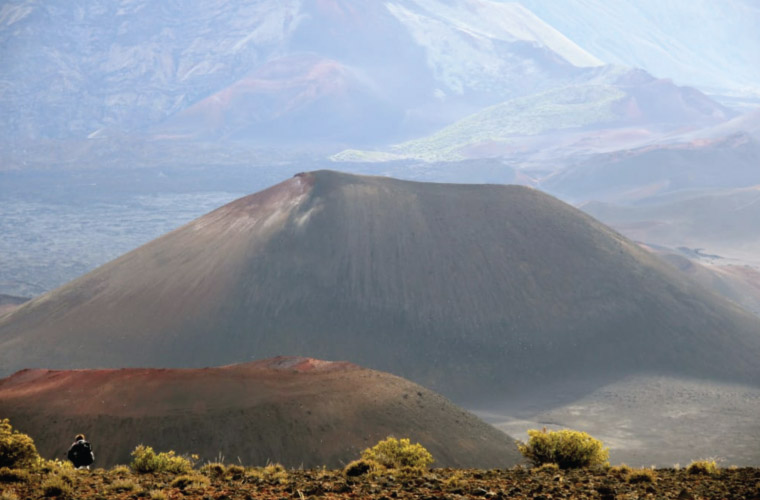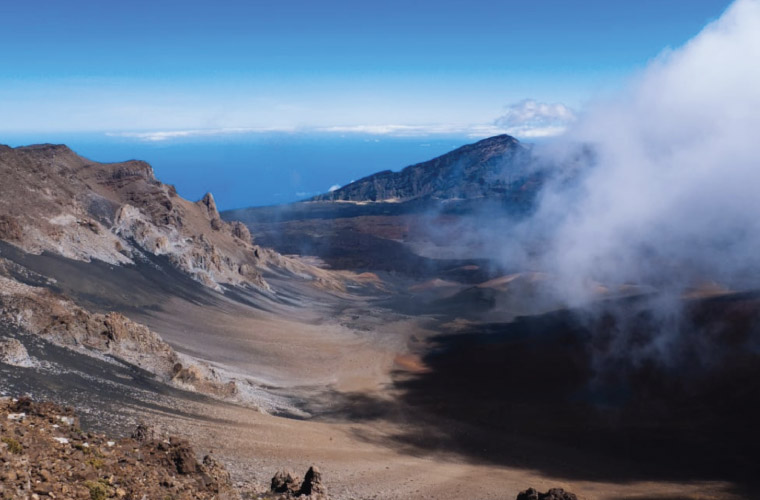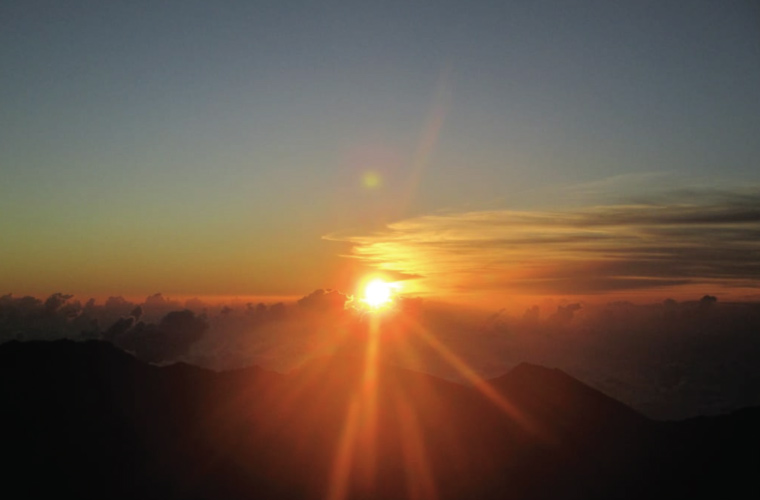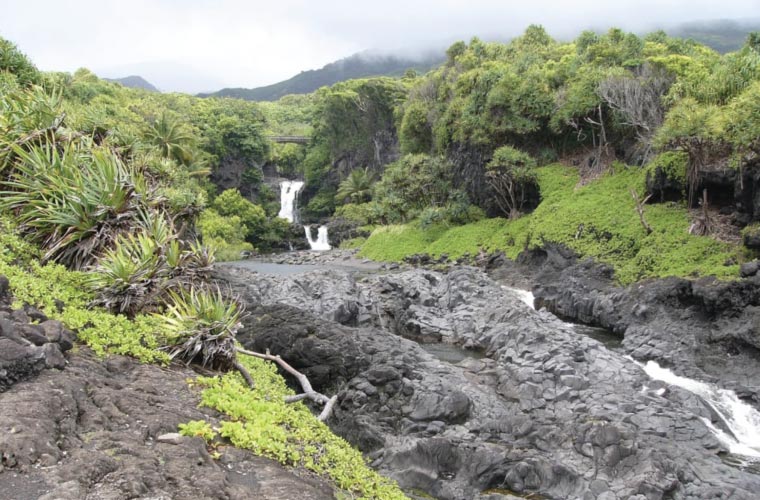Insider’s Guide to Haleakalā National Park
Posted by Abbie Mood on 13th Aug 2021
As if people needed another reason to visit the Hawaiian island of Maui besides the gorgeous beaches and crystal clear water, there is also Haleakalā National Park. When the volcanic cones deep in the ocean erupted, pouring out lava and piling up for millions of years to create the Hawaiian Islands, two shield volcanoes were close enough together that the lava overlapped one another to create a single island. Called a “volcanic doublet”, the result is what we know today as the island of Maui. The older volcano is very eroded and forms the peaks of Mauna Kahalawai (the West Maui Mountains), while Haleakalā, which last erupted in 1600 AD, is more than 10,000 feet above sea level and forms about 75% of the island of Maui.
Like many places in Hawaii, the area is rich in lore. According to Hawaiian legend, Haleakalā, which means "house of the sun", was where the demigod Maui (an ancient Polynesian navigator) harnessed the sun, releasing it only after it agreed to move more slowly across the sky. In 1916, Haleakalā National Park was originally part of Hawaii National Park, which is based on the Big Isalnd of Hawaii, but was made a separate national park in 1961. In 1980, the park became a United Nations International Biosphere Reserve because of its diversity.

Kama‘oli‘i and Pu‘u o Māui craters.
The road to the park starts at sea level and goes up to over 10,000 feet in elevation in 38 miles, traveling through several climate zones that range from humid subtropical lowlands to subalpine desert. Although all of the plants and animals on the island came via people or through the air/sea, they had to make evolutionary adaptations to survive once they got there. Today, there are more endangered species in Haleakalā National Park than in any other national park in the United States.
Haleakalā National Park covers 33,450 acres and there are two sections to the park. The most popular section is around Haleakalā, but there is another section called Kipahulu, which is on the eastern side of the island. Activities in the park include hiking and backpacking, and stargazing. Once on the summit, visitors can see up to 115 miles away, and there are frequent spottings of rainbows, moonbows, and clear views of stars and other planets at night.
Classic Adventures
The best way to see the park is by foot, and with trails ranging from less than .5 miles up to 20+ miles, there is something for just about everyone. On the shorter side is Leleiwi Overlook, where visitors will find rare plants and insects. If you visit at sunset from March to October, you may hear the calls of endangered burrowing seabirds known as the ‘ua’u . The Pa Ka’oao Trail is another short trail, but has some of the best views in the park.
For those up to the challenge, take the 10-mile roundtrip trek up to the summit of Haleakalā. The crater is almost seven miles wide, and the Halemau'u and Sliding Sands trails go down into the crater for an extended hike. There are also cabins that visitors can reserve to spend the night.

Looking down into Haleakalā.
Speaking of overnight, a great overnight route is the Keonehe’ehe’e Trail. Starting at the visitor center, the trail heads down through a cinder desert to the crater floor. The name keonehe’ehe’e describes how a he’e (octopus) moves around the reef, which is how hikers might feel climbing the soft cinders on the way back up the steep trail (awkward and slow). There are two cabins along the trail where people can spend the night—the Kapalaoa Cabin, which is 5.6 miles out, and the Palikū Cabin, which is 9.3 miles from the trailhead.
It’s a long drive to the Kīpahulu Area, but the 68-mile Hāna Highway with its 620 hairpin curves and 59 bridges, is one of the most scenic drives in Hawaii, if not in the entire United States. Kīpahulu has just a few miles of trails in a tropical coastal environment, but its worth the drive to see Waikomu Falls or the Pools of ‘Ohe’o (also known as the Seven Sacred Pools). The park prohibits getting in the water—even when it looks calm, a flash flood could happen, and it’s easy to slip on the rocks and get swept out to sea.
There are several companies that take visitors on tours of the park or on helicopter rides to see some of the inaccessible wilderness sections of the parks. Besides stargazing, seeing the sunrise or the sunset from the summit is an amazing experience.

Sunrise from the summit of Haleakalā,
Secrets of the Park
The 18-mile roundtrip Kaupo Trail is long and strenuous, but has been called one of the most spectacular places in the world. It’s actually easier to hike up the trail from the ocean than downhill from the trailhead. While the summit of Haleakalā gets just 30 inches of rain each year, there is a big bog above the cliff on the Kaupo Trail that gets more than 420 inches each year, creating a lush landscape with waterfalls galore. Hikers walk along the cliff with breathtaking views of southeast Maui and can usually see the Big Island over 90 miles away. Because it is out-and-back, hikers can go out as far as they want and then turn around, so it doesn't have to be an 18 mile trip. The entire trail goes out of the park boundaries onto private property, so be sure to stay on the trail.
Immerse Yourself
Haleakalā National Park is a popular place, but you can avoid some of the crowds by camping out. There are several backcountry cabins, two primitive backcountry campsites, and two more developed campgrounds that are accessible by car. Stay at least one night to see a sunrise and a sunset and to take advantage of the amazing stargazing at the park. It's almost always clear and very dark at night—you can even see the Milky Way with your naked eye! It’s really worth at least two days to explore the Haleakalā summit area and then another day to drive over and explore Kipahulu.

The waterfalls in Kīpahulu.
How to Get the Most Out of Your Visit
- Be prepared for any kind of weather. Kipahulu is pretty much always hot, humid, and rainy, but Haleakalā has a variety of temperatures and conditions and can quickly go sunny and warm to windy and freezing.
- Always pay attention to speed limits—there are many endangered species in the area and you don’t want to accidentally run into one of them.
- The summit of Haleakalā is considered sacred to Native Hawaiians, so be quiet and respectful when visiting.
- You can visit the park year round, but the most rain is in the winter. There are less crowds on the summit after 3 p.m.
Written by Abbie Mood for RootsRated and legally licensed through the Matcha publisher network. Please direct all licensing questions to legal@getmatcha.com.
Share on:

